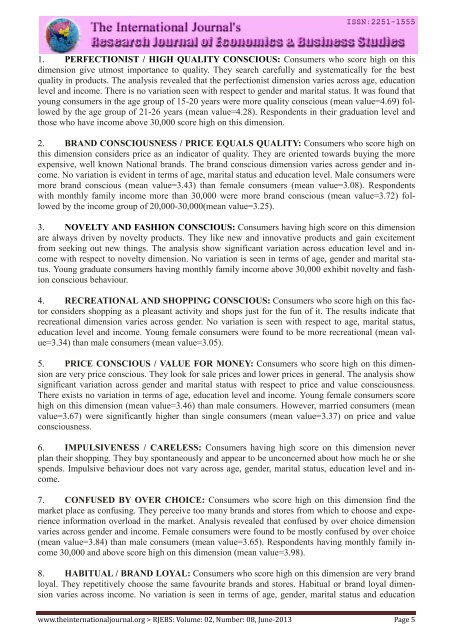Research Journal of Economics & Business Studies - RJEBS - The ...
Research Journal of Economics & Business Studies - RJEBS - The ...
Research Journal of Economics & Business Studies - RJEBS - The ...
- No tags were found...
Create successful ePaper yourself
Turn your PDF publications into a flip-book with our unique Google optimized e-Paper software.
1. PERFECTIONIST / HIGH QUALITY CONSCIOUS: Consumers who score high on this<br />
dimension give utmost importance to quality. <strong>The</strong>y search carefully and systematically for the best<br />
quality in products. <strong>The</strong> analysis revealed that the perfectionist dimension varies across age, education<br />
level and income. <strong>The</strong>re is no variation seen with respect to gender and marital status. It was found that<br />
young consumers in the age group <strong>of</strong> 15-20 years were more quality conscious (mean value=4.69) followed<br />
by the age group <strong>of</strong> 21-26 years (mean value=4.28). Respondents in their graduation level and<br />
those who have income above 30,000 score high on this dimension.<br />
2. BRAND CONSCIOUSNESS / PRICE EQUALS QUALITY: Consumers who score high on<br />
this dimension considers price as an indicator <strong>of</strong> quality. <strong>The</strong>y are oriented towards buying the more<br />
expensive, well known National brands. <strong>The</strong> brand conscious dimension varies across gender and income.<br />
No variation is evident in terms <strong>of</strong> age, marital status and education level. Male consumers were<br />
more brand conscious (mean value=3.43) than female consumers (mean value=3.08). Respondents<br />
with monthly family income more than 30,000 were more brand conscious (mean value=3.72) followed<br />
by the income group <strong>of</strong> 20,000-30,000(mean value=3.25).<br />
3. NOVELTY AND FASHION CONSCIOUS: Consumers having high score on this dimension<br />
are always driven by novelty products. <strong>The</strong>y like new and innovative products and gain excitement<br />
from seeking out new things. <strong>The</strong> analysis show significant variation across education level and income<br />
with respect to novelty dimension. No variation is seen in terms <strong>of</strong> age, gender and marital status.<br />
Young graduate consumers having monthly family income above 30,000 exhibit novelty and fashion<br />
conscious behaviour.<br />
4. RECREATIONAL AND SHOPPING CONSCIOUS: Consumers who score high on this factor<br />
considers shopping as a pleasant activity and shops just for the fun <strong>of</strong> it. <strong>The</strong> results indicate that<br />
recreational dimension varies across gender. No variation is seen with respect to age, marital status,<br />
education level and income. Young female consumers were found to be more recreational (mean value=3.34)<br />
than male consumers (mean value=3.05).<br />
5. PRICE CONSCIOUS / VALUE FOR MONEY: Consumers who score high on this dimension<br />
are very price conscious. <strong>The</strong>y look for sale prices and lower prices in general. <strong>The</strong> analysis show<br />
significant variation across gender and marital status with respect to price and value consciousness.<br />
<strong>The</strong>re exists no variation in terms <strong>of</strong> age, education level and income. Young female consumers score<br />
high on this dimension (mean value=3.46) than male consumers. However, married consumers (mean<br />
value=3.67) were significantly higher than single consumers (mean value=3.37) on price and value<br />
consciousness.<br />
6. IMPULSIVENESS / CARELESS: Consumers having high score on this dimension never<br />
plan their shopping. <strong>The</strong>y buy spontaneously and appear to be unconcerned about how much he or she<br />
spends. Impulsive behaviour does not vary across age, gender, marital status, education level and income.<br />
7. CONFUSED BY OVER CHOICE: Consumers who score high on this dimension find the<br />
market place as confusing. <strong>The</strong>y perceive too many brands and stores from which to choose and experience<br />
information overload in the market. Analysis revealed that confused by over choice dimension<br />
varies across gender and income. Female consumers were found to be mostly confused by over choice<br />
(mean value=3.84) than male consumers (mean value=3.65). Respondents having monthly family income<br />
30,000 and above score high on this dimension (mean value=3.98).<br />
8. HABITUAL / BRAND LOYAL: Consumers who score high on this dimension are very brand<br />
loyal. <strong>The</strong>y repetitively choose the same favourite brands and stores. Habitual or brand loyal dimension<br />
varies across income. No variation is seen in terms <strong>of</strong> age, gender, marital status and education<br />
www.theinternationaljournal.org > <strong>RJEBS</strong>: Volume: 02, Number: 08, June-2013 Page 5

















